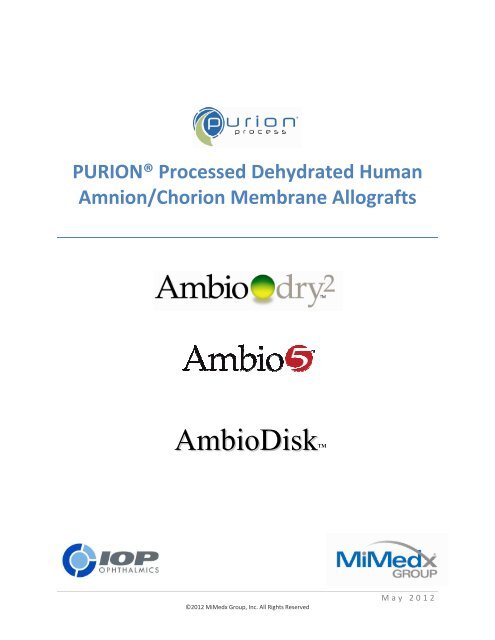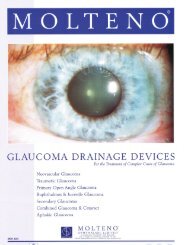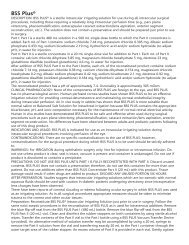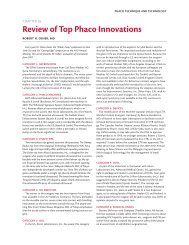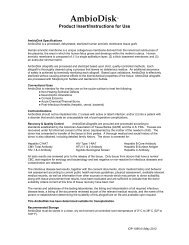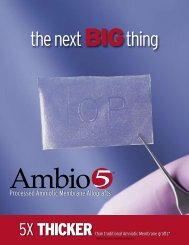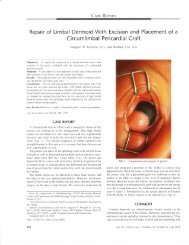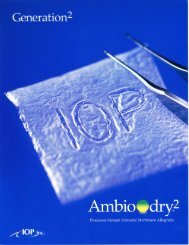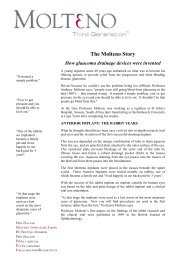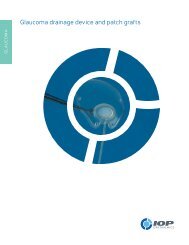PURION® Processed Dehydrated Human Amnion/Chorion - IOP Inc
PURION® Processed Dehydrated Human Amnion/Chorion - IOP Inc
PURION® Processed Dehydrated Human Amnion/Chorion - IOP Inc
Create successful ePaper yourself
Turn your PDF publications into a flip-book with our unique Google optimized e-Paper software.
PURION® <strong>Processed</strong> <strong>Dehydrated</strong> <strong>Human</strong><br />
<strong>Amnion</strong>/<strong>Chorion</strong> Membrane Allografts<br />
AmbioDisk<br />
©2012 MiMedx Group, <strong>Inc</strong>. All Rights Reserved<br />
M a y 2 0 1 2
INTRODUCTION<br />
<strong>Human</strong> amniotic membrane allografts have been used for a variety of reconstructive surgical procedures<br />
since the early 1900s. Interest in utilization of amniotic membrane waned in the early 1980’s as a result<br />
of communicable diseases such as HIV/AIDS, Hepatitis, etc. In the late 1990’s and early 2000’s amnion<br />
re-appeared in cryopreserved form for the treatment of ophthalmic wounds. In 2007, the use of the<br />
amniotic membrane as an allograft accelerated because Surgical Biologics, a MiMedx Group Company,<br />
developed the PURION® Process, which among other things allowed the tissue to be dehydrated and<br />
sterilized. This produced an easy to use graft with room temperature storage and a five-year shelf life.<br />
To date, 70,000 allografts have been distributed for human implantation in various surgical applications.<br />
The PURION Process allografts – AmbioDry2, Ambio5® and AmbioDisk (<strong>IOP</strong> Ophthalmics)- were first<br />
used in ophthalmic surgery where there have been over 40,000 implants to date without any adverse<br />
events associated with the tissue. Most recently, amniotic membrane has been utilized as a potent<br />
facilitator of wound healing in various fields within medicine including lower extremity ulcers but also<br />
eye surgery, burns, gynecologic surgery, orthopedics, and a variety of other applications. 1,2,3,4,5,6,7<br />
AMNIOTIC MEMBRANE ALLOGRAFT DESCRIPTION<br />
<strong>Human</strong> amniotic membrane is comprised of the innermost layer of the placenta and lines the amniotic<br />
cavity. The membrane is composed of multiple layers which include a single layer of epithelial cells, a<br />
basement membrane and an avascular connective tissue matrix. The tissues of the placenta present a<br />
very complex interrelationship of materials that possess numerous physiologic characteristics, which can<br />
in turn change in importance with the appropriate stage of gestation. During pregnancy, the placenta<br />
permits the passage of nutrients, metabolites and metabolic gases, and provides physical and<br />
immunological protection to the developing fetus. In addition, it produces a variety of steroids and<br />
important metabolic hormones. 8<br />
Amniotic membrane is a unique material and its composition contains collagen types IV, V, and VII.<br />
Amniotic membrane is composed of structural extracellular matrix (ECM) which also contains specialized<br />
proteins fibronectin, laminins, proteoglycans and glycosaminoglycans. In addition, amniotic membrane<br />
contains essential, active, healing growth factors such as epidermal growth factor (EGF), transforming<br />
growth factor beta (TGF-β), fibroblast growth factor (FGF), and platelet derived growth factor (PDGF). 8<br />
Amniotic tissues have shown little to no HLA-A, B, C antigens and β2 microglobulin. 3<br />
Figure 1: Layers within the Amniotic Membrane<br />
©2012 MiMedx Group, <strong>Inc</strong>. All Rights Reserved<br />
2 | P a g e
Surgical Biologics was the first to perfect the process of safely separating placental tissue, cleaning, and<br />
reassembling the amnion and chorion layers, and embossing the graft. Patents have been filed on a<br />
number of these embodiments and processes. This intellectual property began development in 2006,<br />
and has been improved over the last several years.<br />
In addition, the dehydrated amnion/chorion membrane allograft can also be micronized which allows it<br />
to be administered as a topical powder or mixed with saline to create an injectable solution or a topical<br />
gel.<br />
Use of amniotic membrane has recently increased clinically as an allograft material for chronic and acute<br />
wound care management, for scar tissue reduction, as a barrier membrane, and as a soft tissue<br />
regeneration graft.<br />
THE PURION PROCESS<br />
The PURION Process is a patent pending process that safely and gently separates placental tissues,<br />
cleans and reassembles various layers, and then dehydrates this tissue in a way that preserves the key<br />
elements associated with healing. The sterilized tissue is packaged and stored at room temperature and<br />
has a 5-year shelf life. The tissue may be delivered in a dried sheet configuration using an on-lay surgical<br />
or clinical technique. <strong>Dehydrated</strong> amnion/chorion membrane allograft can also be micronized to create<br />
a powder configuration which can be administered as a topical powder or can be mixed with a saline to<br />
create an injectable solution.<br />
PURION processed dehydrated amniotic tissue is regulated under Section 361 of the Public Health<br />
Service Act by the United States Food and Drug Administration (FDA). PURION processed dehydrated<br />
allografts are minimally manipulated and intended for homologous use.<br />
Table 1: FDA Regulatory Classifications for Tissue and Cell Based Products<br />
Regulatory Pathway Material Requirements<br />
361 HCT/Ps<br />
(<strong>Human</strong> Cell Tissue/<br />
Products)<br />
510(k) Clearance<br />
Premarket Approval<br />
(PMA)<br />
New Drug Application<br />
(NDA)<br />
<strong>Human</strong> Tissue (Allograft)<br />
Medical Device<br />
(Example: decellularized human<br />
dermis, xenografts, collagen<br />
dressings, bone void filler)<br />
Medical Device<br />
(Example: human living skin<br />
substitutes, bone substitute)<br />
Drug<br />
(Example: living stem cells nonautologous,<br />
or second degree<br />
relative)<br />
Minimally manipulated, intended for<br />
homologous use. No clearance or pre-market<br />
approval needed. Requires FDA Good Tissue<br />
Practices (GTP)<br />
Requires FDA Substantial Equivalence, shorter<br />
submission and less required verses PMA. Based<br />
on predicate device. Requires FDA Current Good<br />
Manufacturing Practice (cGMP)<br />
Requires extensive FDA Pre-Market approval<br />
process, including comprehensive clinical trials.<br />
Requires FDA Current Good Manufacturing<br />
Practice (cGMP)<br />
Requires extensive FDA Pre-Market approval<br />
process, including comprehensive clinical trials.<br />
Requires FDA Current Good Manufacturing<br />
Practice (cGMP)<br />
©2012 MiMedx Group, <strong>Inc</strong>. All Rights Reserved<br />
3 | P a g e
TISSUE CONFIGURATIONS<br />
Membrane allograft: This configuration is delivered as a dry sheet embossed with the monogram “<strong>IOP</strong>”,<br />
which enables the user to identify the correct orientation prior to the application of the graft. The<br />
allograft may be used as presented on opening the package, or alternatively by moistening prior to use<br />
with normal saline solution. The tissue is for single use and single<br />
patient application.All PURION processed<br />
amniotic membrane<br />
allografts are dehydrated and packaged aseptically into an inner peel<br />
pouch and sealed with an outer peel pouch system within a clean<br />
room environment. The outer peel pouch is NOT considered sterile.<br />
The inner pouch, which contains the graft, is considered sterile unless<br />
damaged or compromised.<br />
SOURCE OF AMNIOTIC TISSUE<br />
Eligible amnion donors are living mothers that have delivered a live birth through Cesarean<br />
section. All tissues are recovered under full informed consent of the donor. Each donor<br />
must then answer a series of questions to ensure the donor has not engaged in behaviors<br />
to place her at an increased risk for the transmission of infectious diseases and to ensure<br />
the donor has not shown signs or symptoms of illnesses. Donor procurement and screening<br />
processes were developed to prevent the transmission of infectious diseases from donors<br />
to recipients of the material. These processes follow the FDA regulations and American Association of<br />
Tissue Banks (AATB) standards.<br />
The donor screening process also includes the completion of a physical examination ation of the donor<br />
mother by the attending physician. This exam is performed to ensure the donor mother does not<br />
exhibit any physical evidence of high risk factors, such as infectious disease. A physical exam is<br />
performed and documented according to established procedures. Donor testing is performed on a<br />
blood specimen from each donor which meets the requirements of the FDA and the AATB. In Table 2<br />
see a list of communicable disease tests performed on amniotic tissue allografts before undergoing the<br />
PURION Process.<br />
In addition to donor testing and screening, an additional element of testing includes performance of<br />
microbial cultures from the tissue at the time of recovery to detect the presence of bacterial<br />
contaminants. All test results for serology, bacteriology and infectious diseases are reviewed prior to<br />
the release of the donor tissue. Only tissue from donors with acceptable test results according to the<br />
standards of the company as well as the standards of all state and federal regulatory bodies are<br />
released.<br />
©2012 MiMedx Group, <strong>Inc</strong>. All Rights Reserved<br />
4 | P a g e
All serological testing for bacterial, viral and infectious diseases are performed on blood specimens for<br />
each donor and meets the requirements of the FDA regulations and AATB standards, specifically section<br />
D4.354, Required Infectious Disease Tests, of the Standards for Tissue Banking. The full testing panel<br />
includes:<br />
Table 2: Infectious Diseases Screened for in Tissue Transplantation<br />
HIV-1 & HIV-2 Antibody Hepatitis B Core Antibody Hepatitis C Virus (Nucleic Acid Test)<br />
HIV Type 1 (Nucleic Acid Test)<br />
HTLV-1 & HTLV-2 Antibody<br />
TISSUE SAFETY<br />
Hepatitis B Surface Antigen<br />
Hepatitis C Antibody<br />
CMV Total Antibody<br />
Syphilis (Serological Test)<br />
To verify the ability of the PURION Process to provide microbial reduction, a disinfection validation was<br />
originally performed by an ISO certified laboratory. <strong>Amnion</strong> tissue samples were contaminated with 5%<br />
bovine serum containing Staphylococcus aureus, Escherichia coli, Pseudomonas aeruginosa,<br />
Staphylococcus epidermidis, Candida albicans, and Bacillus subtilis. Bioburden extractions were<br />
performed to determine the number of viable organisms present on one positive control for each<br />
organism. <strong>Amnion</strong> tissue samples contaminated with the organisms were disinfected through the<br />
PURION Process, and another bioburden assay was performed to determine the bioload reduction of<br />
each amnion sample. Results obtained during the decontamination process validation testing were all<br />
below the established acceptance criteria. Therefore, test results demonstrate that the<br />
decontamination process can be considered an effective supplement to the standard terminal<br />
sterilization process.<br />
TISSUE PROCESSING<br />
Surgical Biologics has created the proprietary and patent pending PURION Process for<br />
amniotic membrane preparation. The proprietary process has been specifically<br />
designed to deliver a safe, effective and minimally manipulated allograft tissue. All<br />
placental tissues are recovered under sterile conditions from patients who have been<br />
screened for underlying infectious disease. At no time are the recovered tissues ever<br />
subjected to ultra-low or ultra-high temperatures during quarantine, processing, or<br />
storage. No chemicals are used in the PURION Process which might result in chemical<br />
cross-linking or decellularization.<br />
Tissue stabilization tion is accomplished by a dehydration step. Using this methodology, the<br />
delicate collagen matrix remains structurally intact. During the dehydration process, a patent pending<br />
orientation embossment (“SB”) is incorporated onto each graft in the PURION Process. This also helps<br />
to ensure proper graft placement during surgical implantation. After processing of the tissue is<br />
complete the tissue graft provides no living cells to the patient. Finally, an inner and outer peel pouch<br />
system is used for packaging which is then sterilized with Electron-beam irradiation which addresses any<br />
potential remaining bioburden. The final implantable PURION processed dehydrated human<br />
amnion/chorion allografts can be stored at room temperature (0° to 38°C/32°F to 100° °F) for up to fiveproduct<br />
is inspected prior to release to confirm the manufacturing process has been<br />
years. The final completed according to procedure.<br />
©2012 MiMedx Group, <strong>Inc</strong>. All Rights Reserved<br />
5 | P a g e
The PURION Process also employs some unique steps that are unlike some traditional allograft tissues<br />
processes:<br />
Step 1: The placenta is recovered under sterile conditions within an operating room environment<br />
immediately following child delivery. The placenta is then placed into a sterile transfer container with a<br />
proprietary hypertonic solution. At no time is the recovered tissue subjected to ultra-low low temperatures<br />
during quarantine storage.<br />
Step 2: The placental tissues are transferred from quarantine storage to a Class 100 biological safety<br />
cabinet. The membrane layers go through a series of proprietary gentle washes and sterile water rinses<br />
to remove unwanted biological material.<br />
Step 3: Tissue stabilization is accomplished by dehydration. Using this<br />
methodology, the delicate extracellular matrix (ECM) (collagen, elastin,<br />
etc) and cells remain structurally intact. In comparison, lyophilization or<br />
freeze drying would introduce ice crystal formation that could cause<br />
damage to cellular architecture. During the dehydration process, an<br />
orientation embossment is incorporated onto each graft. This ensures<br />
proper graft placement during surgical implantation. The embossment<br />
process does not change the biologic or structural integrity of the graft.<br />
Step 4: An inner and outer peel pouch system is used for packaging both membrane and micronized<br />
versions of the dehydrated human amnion/chorion allografts. The outer pouch is considered non-sterile<br />
with the inner being sterile. All packaged tissues are then dosed with Electron-Beam irradiation which<br />
addresses any potential remaining bio-burden.<br />
TISSUE STERILITY<br />
Sterilization validation was conducted according to the standards established by the International<br />
Organization ion for Standardization (ISO) and the Association for the Advancement of Medical<br />
Instrumentation (AAMI) for the substantiation of a chosen sterilization dose to attain a sterility<br />
assurance level of 10ˉ6 substantiating the ability of the selected radiation dose to produce a sterile<br />
product.<br />
Specific insight into donor suitability determination is provided by the Surgical Biologics medical<br />
director, a pathologist certified by the American Board of Pathology in the areas of clinical pathology<br />
and blood banking/transfusion medicine.<br />
The infectious disease test results, together with the consent document, donor medical history and<br />
behavioral risk assessment, physical examination, available records, and along with tissue procurement<br />
test results are evaluated by a medical director and must be determined to be sufficient to indicate that<br />
the donor suitability criteria have been met before the release of donor tissue for transplant. Strict<br />
guidelines are maintained for each step of the tissue processing. All recovery and processing operations,<br />
including donor eligibility determination, are performed in strict adherence to FDA Regulations and the<br />
standards that have been established by the AATB as well as applicable state and local regulatory<br />
requirements.<br />
©2012 MiMedx Group, <strong>Inc</strong>. All Rights Reserved<br />
6 | P a g e
SCIENTIFIC EVIDENCE<br />
Laboratory tests have been conducted to provide proof that PURION processed human amniotic tissue<br />
allografts do contain active growth factors to enhance soft tissue wound healing.<br />
Hypothesis: Do PURION processed dehydrated amniotic tissue allograft membranes<br />
deliver essential growth factors and cytokines?<br />
In vitro tests were conducted on amniotic membrane to confirm the presence of essential soft tissue<br />
healing growth factors such as PDGF AA & BB, bFGF, TGF-b1, and EGF. 9 Of 13 cytokines present in<br />
natural <strong>Amnion</strong>/<strong>Chorion</strong>, all were found in the PURION processed tissue.<br />
Cytokines Present in <strong>Amnion</strong>/ <strong>Chorion</strong> Tissue<br />
Cytokines PDGF-AA PDGF-BB TGF-a TGF-b bFGF EGF VEGF IL-10 IL-4 PIGF TIMP-1 TIMP-2 TIMP-4<br />
Natural <br />
Purion processed <br />
Cytokine test completed by a 3 rd party laboratory: Data on file<br />
Hypothesis: Do micronized PURION processed dehydrated amniotic tissue allografts<br />
deliver essential growth factors over time?<br />
PURION processed dehydrated human amnion/chorion was micronized into a powder like material.<br />
Neutral saline was used to rehydrate the micronized amniotic tissue and then centrifuged for ten<br />
minutes to create a supernatant liquid and solid material pellet. The supernatant liquid was tested for<br />
PDGF-AA, PDGF-BB, bFGF, TGF-b1 and FGF using ELISA protocols. The results were approximately 50%<br />
of the EGF, TGF-b, bFGF and PDGF-BB was found<br />
to be released into solution, except for PDGF-AA.<br />
PDGF-AA only released 21% in to solution.<br />
As the remaining solid is absorbed over time, it<br />
has been proposed that the growth factors still<br />
bound into the extracellular matrix are released<br />
into the surrounding tissue, providing a continual<br />
release of growth factors during the tissue<br />
regeneration process. 9<br />
Determined by ELISA Assay (N=5)<br />
©2012 MiMedx Group, <strong>Inc</strong>. All Rights Reserved<br />
7 | P a g e
Hypothesis: Do PURION processed dehydrated human amniotic tissue allografts<br />
promote cell proliferation?<br />
The effects of dehydrated human amniotic membrane on cell proliferation were assessed in vitro using<br />
human dermal fibroblasts (HDF). 10 Test media was generated through the incubation (37°C for 16<br />
hours) of 2 ml serum free culture media with varying amounts of dehydrated human amniotic<br />
membrane (1 , ½ , ¼, ⅛ of a 16 mm diameter membrane disk). In addition serum free and 10% serum<br />
culture media were also incubated to provide negative and positive controls respectively. The HDF cells<br />
were incubated (37°C, 5% CO 2 ) with test media, negative and positive controls for 72 hours. Cell<br />
proliferation was then measured using XTT cell proliferation assay. In addition, test culture media was<br />
analyzed for PDGF-AA using an ELISA in order to relate cell proliferation levels to growth factor release.<br />
Chart 1: Cell proliferation amounts based on membrane size<br />
n=3<br />
** = P
Hypothesis: Do PURION processed dehydrated human amniotic tissue allografts<br />
promote cell migration?<br />
The effects of dehydrated human amniotic membrane on human cell migration were evaluated in vitro<br />
in a trans-well culture apparatus, Diagram 1, according to established methods. <strong>Human</strong> cells were<br />
cultured in the upper chamber and PURION processed dehydrated human amniotic membrane was<br />
placed in the lower chamber. 11<br />
Diagram 1: Trans-well culture apparatus<br />
The number of human cells migrating<br />
through the porous membrane was<br />
counted after 24 hours of culture. Cell<br />
counts of migrating cells per<br />
micrograph relative to the PBS positive<br />
control are depicted in Chart 2.<br />
Statistically higher cell counts were<br />
observed in High (12x13mm or<br />
156mm 2 ) and Medium-sized (4mm<br />
diameter disk or 12.6mm 2 ) samples<br />
relative to the Low (1.5mm diameter disk or 1.77mm 2 ) counterpart and the No Serum negative control.<br />
Chart 2 demonstrates that increased cell migration correlates with higher amounts of PURION processed<br />
dehydrated human amniotic membrane.<br />
Chart 2: Percent of cell migration relative to size of graft<br />
100<br />
% migration relative to positive control<br />
90<br />
80<br />
70<br />
60<br />
50<br />
40<br />
30<br />
20<br />
10<br />
*<br />
*<br />
n=6<br />
0<br />
No Serum Low Medium High<br />
1.77mm 2 12.6mm 2 156mm 2<br />
* indicates significantly higher (p ≤ 0.05) migration rate than both No Serum and Low group<br />
©2012 MiMedx Group, <strong>Inc</strong>. All Rights Reserved<br />
9 | P a g e
CLINICAL USES<br />
Amniotic tissue has unique properties that reduce scar tissue formation, reduce inflammation and<br />
support soft tissue regeneration. The potential medical uses of the tissue inside and outside of the body<br />
are broad. This tissue can be utilized in procedures where reduction in scar tissue or regeneration of a<br />
soft tissue is beneficial. Amniotic membranes have been employed in the treatment of full and partialthickness<br />
acute internal and external and chronic wounds. Both membrane and micronized dehydrated<br />
amnion/chorion membrane allografts have been used in the treatment of internal soft tissue healing<br />
including, but not limited to tendons, ligaments and skin. The dehydrated human amnion/chorion<br />
allografts can be used in a powder form for acute suture lines and hard to cover areas.<br />
Some major clinical uses or proposed uses for membrane and micronized dehydrated human<br />
amnion/chorion allografts include:<br />
Ophthalmology/Eye Surgery<br />
Conjunctivolplasty<br />
Pterygium excision<br />
Non-healing epithelial defects (overlay graft)<br />
Conjunctival chalasis<br />
Corneal ulcers<br />
Fornix Reconstruction<br />
Chemical and thermal burns<br />
Wound Healing of acute and chronic, full and partial thickness wounds<br />
o Delayed healing ulcers of various etiologies including diabetic foot ulcers, venous leg ulcers,<br />
arterial ulcers, pressure ulcers, post-surgical or post traumatic wound dehiscence, burns,<br />
acute suture line repairs, etc.<br />
o Subcutaneous wound tunnel repair<br />
General/ OBGYN/ Vascular Surgery (to reduce scar tissue formation and enhance soft tissue healing after primary repair)<br />
o General use in dermal scar revision by plastic/reconstructive surgery<br />
o <strong>Inc</strong>ision with primary closure using graft<br />
o Vascular surgery vessel repair grafts<br />
o Reconstruction/revision, flap graft with tissue<br />
o Inguinal hernia repair with mesh<br />
o Ventral umbilical hernia repair<br />
o Prostatectomy surgery for protection of nerve plexus<br />
o Craniotomy surgery, to prevent scarring in flap scar reduction<br />
Spine/ Orthopedic/Sports Medicine (to reduce scar tissue formation and enhance soft tissue healing after primary repair)<br />
o Spine surgery – as a cover for dura to reduce scar formation<br />
o Total knee arthroplasty / Total knee replacement<br />
o Rotator cuff/ labial repair<br />
o Tendonitis, bursitis, plantar fasciitis (golfer’s and tennis elbow, jumper’s knee)<br />
Ear, Nose, and Throat/ Dental<br />
o Tympanoplasty (ear drum repair)<br />
o Nasal septum repair<br />
o Periodontal surgery and periodontal repair<br />
©2012 MiMedx Group, <strong>Inc</strong>. All Rights Reserved<br />
10 | P a g e
PATIENT SAFETY<br />
MiMedx’s focus on patient safety is evident in the development and validation of the PURION Process as<br />
well as continuous monitoring of the use of the tissue. MiMedx has attained voluntary AATB<br />
accreditation and complies with rigorous AATB standards. In addition, the innate properties of the<br />
human amniotic tissue provide an immunoprivileged material which reduces the likelihood of rejection<br />
or allergic reaction. Thousands of applications of PURION processed amnion/chorion composite grafts in<br />
the eye, a highly sensitive indicator of irritation, further support the continuous use of the tissue and the<br />
lack of reaction by the patient. Ocular irritation tests including GLP ISO tests 12 carried out by an<br />
independent lab further demonstrated that the material does not cause an inflammatory response in<br />
the standard test.<br />
CONCLUSION<br />
The use of human amniotic membrane over the past 100 years has produced a significant amount of<br />
data in multiple areas of medicine. Based upon relevant immuno-histochemisty, ELISA, cell migration<br />
and proliferation studies conducted by MiMedx and independent laboratories on PURION processed<br />
dehydrated human amniotic membrane it is clear the patent pending PURION Process provides a<br />
minimally manipulated and carefully preserved amniotic tissue which contains essential growth factors<br />
and extra-cellular matrix within the membrane. The sterilized dehydrated human amniotic membrane is<br />
processed to provide an easy to use, safe surgical option for multiple surgical applications while<br />
providing a 5-year shelf-life at room temperature. Initial scientific evidence supports the hypothesis that<br />
many of the key components present in natural amniotic membrane are preserved during the gentle<br />
preservation of the PURION Process, which accounts for the advantageous clinical properties observed<br />
when the allografts are used in the clinical applications described.<br />
©2012 MiMedx Group, <strong>Inc</strong>. All Rights Reserved<br />
11 | P a g e
References:<br />
1 Niknejad H; Peirovi H; Jorjani M; Ahmadiani A; Ghanavi J; Seifalian AM "Properties of the amniotic membrane for<br />
potential use in tissue engineering." Eur Cell Mater. (15). 01-JAN-2008. pp 88 - 99.<br />
2 Rahman I; Said DG; Maharajan VS; Dua HS "Amniotic membrane in ophthalmology: indications and limitations." Eye.<br />
(23)10. 2009. pp 1954–1961.<br />
3 Baradaran-Rafii A; Aghayan H; Arjmand B; and Javadi M. "Amniotic Membrane Transplantation." Iran J Ophthalmic Res.<br />
(2)1. 2007. pp 58-75.<br />
4 John, T. "<strong>Human</strong> amniotic membrane transplantation: Past, present, and future.." Ophthal Clin N Am. (16). 2003. pp 43-<br />
65.<br />
5 Adly OA; Moghazy AM; Abbas AH; Ellabban AM; Ali OS; Mohamed BA "Assessment of amniotic and polyurethane<br />
membrane dressings in the treatment of burns." Burns - 01-AUG-2010; 36(5): 703-10.<br />
6 Huiren Tao & Hongbin Fan "Implantation of amniotic membrane to reduce postlaminectomy epidural adhesions." Eur<br />
Spine J - 01-AUG-2009; 18(8): 1202-12. (). 2009.<br />
7 Arora R; Mehta D; Jain V "Amniotic membrane transplantation in acute chemical burns." Eye (Lond). (19)3. 01-MAR-2005.<br />
pp 273-8.<br />
8 Kay H; Nelson D; Wang Y. “The Placenta: From Development to Disease.” Wiley-Blackwell. 2011.<br />
9 MiMedx Internal Report - SRB-100001.00<br />
10 MiMedx Internal Report “The effects of EpiFix on cell proliferation In-Vitro” Research conducted by third party.<br />
11 MiMedx Internal Report - SRB -100005.00 “<strong>Amnion</strong>-influenced cell migration” Research conducted by third party.<br />
12 MiMedx Internal Report- “ISO 10993-10: Biological Evaluation of Medical Devices- Part 10- Test for irritation and<br />
delayed-type hypersensitivity- ocular irritation test, <strong>Amnion</strong>/ <strong>Chorion</strong> Composite” Research conducted by third<br />
party.<br />
Distributed by:<br />
Manufactured by:<br />
3184-B Airway Avenue<br />
Costa Mesa, CA 92626 USA<br />
Tel: 714.549.1185 or 800.535.3545<br />
ambio@iopinc.com<br />
www.iopinc.com<br />
60 Chastain Center Blvd, Suite 60<br />
Kennesaw, GA 30144 USA<br />
Tel: 678.384.6720 or 866.477.4219<br />
customerservice@mimedx.com<br />
www.mimedx.com<br />
MiMedx is registered trademarks of MiMedx Group, <strong>Inc</strong>. www.mimedx.com<br />
Surgical Biologics, a MiMedx Group Company.<br />
©2012 MiMedx Group, <strong>Inc</strong>. All Rights Reserved.<br />
<strong>IOP</strong>-A-1900.01<br />
©2012 MiMedx Group, <strong>Inc</strong>. All Rights Reserved<br />
12 | P a g e


